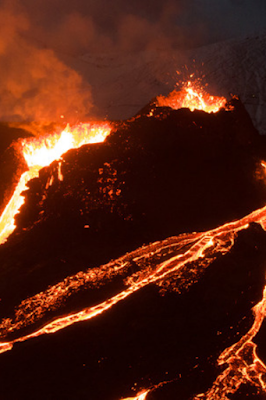volcanic eruption, causes, types, effects and preparedness
Deep
in the earth, its temperatures are hot enough for a lot more rocks to melt
slowly to become a dense fluid called magma. Because it's heavier than solid
rock, magma rises and accumulates in magma chambers. Eventually, some magma
will reach Earth through cracks in a vent. Magmas that explode are called
lavas. Occasionally the eruption has been explosive but not all.
Explosions depend upon a magmatic composition in the eruption. When magma is thin, gases may escape easily. In case a magma eruption occurs it is discharged from a volcano. Several examples of volcanic eruptions are in Hawaii.
What is formed during volcanic eruptions are called lava flows? A volcano releases some of its hot gases when it erupts, creating smaller but powerful explosions that can travel for thousands or even millions (or hundreds) miles through the Earth's atmosphere and land below. As these molten gas particles move up into the stratosphere they expand rapidly—and explode explosively at high altitudes to produce very large pyroclastic cloud bands over a considerable distance from the summit.
Volcanoes may also release tremendous amounts by venting their fluids directly onto surrounding air masses on days where there are no wind changes throughout the day.
The eruption path will begin with relatively low-velocity volcanism.
Volcanic eruptions can cause a lot of damage to the environment. They also have a bad impact on the human population as well as their settlements.
The most common cause of volcanic eruptions is when there is a build-up of pressure in the magma chamber over time. The pressure will eventually be released and an eruption will occur.
A volcanic eruption is a sudden release of gas and lava from a volcano.
Volcanic eruptions are sudden and violent releases of energy that create a mixture of gas, ash, and rock. The eruptions can last from a few minutes to several days.
A volcanic eruption is the release of energy in the form of molten rock, ash, hot gas, and liquids from a volcano.
Volcanoes are geological features that can be found on land, under the sea, and even in the air. The eruptions of volcanoes are classified into three types- effusive, explosive, and hybrid. Effusive eruptions are characterized by the release of lava from a volcano’s vent. This type of eruption is often slow and can last for weeks or months. Explosive eruptions occur when lava reaches the surface quickly, resulting in a sudden release of pressure that causes an explosion. Explosions are usually short-lived but violent. Hybrid eruptions happen when both effusive and explosive events occur simultaneously or consecutively.
A volcanic eruption is the release of molten rock, ash, and gases from a volcanic vent. The term can also refer to any natural event resulting in the ejection of material, such as water or lava, from a volcano.
Also Read: Tips To Start A Container Garden
The effects of volcanic eruptions are far-reaching and devastating.
Volcanic eruptions can cause several different types of effects. The most common effect is an eruption column that rises high into the sky as it releases gases from the Earth’s interior. Ash particles from these columns can be carried long distances by winds, sometimes causing pollution in other parts of the world. Volcanic ash can also disrupt air travel routes because it affects visibility at airports and on runways.
Volcanic eruptions are natural disasters that can have devastating effects.
The ash can cause respiratory problems and prevent sunlight from reaching the ground. The lava can burn anything in its path while the gas emissions can suffocate people in the vicinity.
The other effects of volcanic eruptions include tsunamis, earthquakes, and avalanches.
Volcanoes are geological structures that form when hot molten rock (magma) and ash spew out of a vent in the earth's surface. The molten rock and ash mix with water to create a slurry called "lava." The lava cools and hardens to form a volcano.
Volcanoes are classified as active, dormant, or extinct. Active volcanoes have had recent eruptions, whereas dormant volcanoes have not erupted for some time but maybe expected to erupt again. Extinct volcanoes are those that have not erupted for tens of thousands of years or more.
We should always be prepared for the worst. When living near a volcano, it is important to know what to do in case of an eruption. Here are some tips on how to prepare for the worst.
Make sure you have enough food and water for at least three days.
Stock up on medications, first aid kits, flashlights, batteries, cash, and any other necessities you may need in case of emergency.
Use social media or apps like "Ready" to stay informed about emergency alerts in your area.
For people living in the area of a potential eruption, the most important thing they can do is to be prepared. This includes understanding what to do in emergency situations and how to prepare their homes for an eruption.
Explosions depend upon a magmatic composition in the eruption. When magma is thin, gases may escape easily. In case a magma eruption occurs it is discharged from a volcano. Several examples of volcanic eruptions are in Hawaii.
What is formed during volcanic eruptions are called lava flows? A volcano releases some of its hot gases when it erupts, creating smaller but powerful explosions that can travel for thousands or even millions (or hundreds) miles through the Earth's atmosphere and land below. As these molten gas particles move up into the stratosphere they expand rapidly—and explode explosively at high altitudes to produce very large pyroclastic cloud bands over a considerable distance from the summit.
Volcanoes may also release tremendous amounts by venting their fluids directly onto surrounding air masses on days where there are no wind changes throughout the day.
The eruption path will begin with relatively low-velocity volcanism.
Volcanic eruptions can cause a lot of damage to the environment. They also have a bad impact on the human population as well as their settlements.
The most common cause of volcanic eruptions is when there is a build-up of pressure in the magma chamber over time. The pressure will eventually be released and an eruption will occur.
A volcanic eruption is a sudden release of gas and lava from a volcano.
A volcanic eruption is a sudden release of gas and lava from a volcano.
Volcanic eruptions are sudden and violent releases of energy that create a mixture of gas, ash, and rock. The eruptions can last from a few minutes to several days.
The most common cause of volcanic eruptions is the release of pressure beneath the Earth's surface. This pressure can come from magma (molten rock) or gases building up under the surface.
A volcanic eruption is the release of energy in the form of molten rock, ash, hot gas, and liquids from a volcano.
A volcanic eruption may occur when the pressure that has built up inside the volcano over many years reaches a level that can no longer be contained by the surrounding rocks. This pressure may be caused by either molten rock rising up from below or by steam or hot gases forcing their way out of cracks in the side of a volcano.
Volcanoes are geological features that can be found on land, under the sea, and even in the air. The eruptions of volcanoes are classified into three types- effusive, explosive, and hybrid. Effusive eruptions are characterized by the release of lava from a volcano’s vent. This type of eruption is often slow and can last for weeks or months. Explosive eruptions occur when lava reaches the surface quickly, resulting in a sudden release of pressure that causes an explosion. Explosions are usually short-lived but violent. Hybrid eruptions happen when both effusive and explosive events occur simultaneously or consecutively.
A volcanic eruption is the release of molten rock, ash, and gases from a volcanic vent. The term can also refer to any natural event resulting in the ejection of material, such as water or lava, from a volcano.
The effects of volcanic eruptions are both immediate and delayed. They can include floods, earthquakes, tsunamis, and forest fires. The most immediate effect is that it’s hard for people living near the volcano to breathe because there’s so much ash in the air.
The effects of volcanic eruptions are far-reaching and devastating.
Volcanic eruptions happen when there is a build-up of heat and pressure below the surface, which causes molten rock (magma) to rise to the surface. This creates a vent or opening in the Earth's surface through which gas, ash, and molten rock escape.
Volcanic eruptions can cause several different types of effects. The most common effect is an eruption column that rises high into the sky as it releases gases from the Earth’s interior. Ash particles from these columns can be carried long distances by winds, sometimes causing pollution in other parts of the world. Volcanic ash can also disrupt air travel routes because it affects visibility at airports and on runways.
Volcanic eruptions are natural disasters that can have devastating effects.
The most common effects of volcanic eruptions are ash, lava, and gas emissions.
The ash can cause respiratory problems and prevent sunlight from reaching the ground. The lava can burn anything in its path while the gas emissions can suffocate people in the vicinity.
The other effects of volcanic eruptions include tsunamis, earthquakes, and avalanches.
Volcanoes are geological structures that form when hot molten rock (magma) and ash spew out of a vent in the earth's surface. The molten rock and ash mix with water to create a slurry called "lava." The lava cools and hardens to form a volcano.
Volcanoes are classified as active, dormant, or extinct. Active volcanoes have had recent eruptions, whereas dormant volcanoes have not erupted for some time but maybe expected to erupt again. Extinct volcanoes are those that have not erupted for tens of thousands of years or more.
We should always be prepared for the worst. When living near a volcano, it is important to know what to do in case of an eruption. Here are some tips on how to prepare for the worst.
Know your evacuation route and plan an alternate route if needed.
Make sure you have enough food and water for at least three days.
Stock up on medications, first aid kits, flashlights, batteries, cash, and any other necessities you may need in case of emergency.
Use social media or apps like "Ready" to stay informed about emergency alerts in your area.
For people living in the area of a potential eruption, the most important thing they can do is to be prepared. This includes understanding what to do in emergency situations and how to prepare their homes for an eruption.
Volcanoes are unpredictable and some eruptions happen without warning. The best way for people living near a volcano to prepare is by monitoring it closely and taking necessary precautions when necessary.



.jpeg)


Comments
Post a Comment
please do not enter any spam link in the comment box